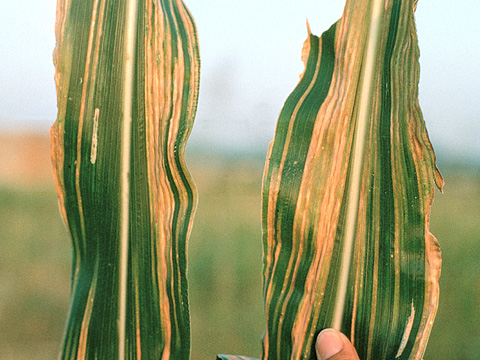Downy mildew of maize, known as Java downy mildew, is a plant disease caused by a fungus called Peronosclerospora maydis. It was first discovered in Java, Indonesia, in 1897 by a scientist named Raciborski. This discovery marked the first report of downy mildew affecting corn plants. Initially, researchers mistakenly identified it as Sclerospora maydis.
The disease later spread to India and was documented by Butler in 1913. Peronosclerospora maydis is an interesting fungus because it can only grow inside the host plant and cannot be cultured on artificial media.
This pathogen has two types of hyphae, which are thread-like structures: straight and sparsely branched, and lobed and irregularly branched. The mycelium, the main body of the fungus, contains many haustoria, which are specialized structures for nutrient absorption.
Clustered conidiophores, structures that produce spores, emerge from tiny openings called stomata on the plant and have two to four branching levels. These branches are sturdy and range from 150 to 550 µm in length, with the base cells measuring between 60 to 180 µm.
The spores, called conidia, are small, clear, and spherical or nearly spherical, typically measuring between 17-23 x 27-39 µm. However, there is some variation in size as Semangoen (1970) suggested slightly smaller dimensions (12-29 x 10-23 µm). Oospores, another type of reproductive structure, have not been observed for this pathogen.
It’s important to note that the disease initially identified in India by Butler (1913) and later described as S. philippinensis by Weston (1920) is not the same as the true Java Downy Mildew found in Indonesia, which is correctly referred to as S. maydis (Rae.) Palm. The genuine Java Downy Mildew pathogen has not been detected in India.
This disease is present in parts of India, including Bihar, Punjab, and the Union Territory of Delhi, where foliar and stalk rot diseases are also common. Assessing the specific losses caused by this pathogen alone is challenging, but in the Philippines, losses due to downy mildew can range from 40-60%, and sometimes even reach 100%. In Indian conditions, losses can be as high as 60%.
Symptoms of Downy Mildew of Maize

Downy mildew of maize exhibits several characteristic symptoms in infected plants. It’s essential to recognize these signs to manage the disease effectively in Indian maize crops.
- Chlorotic Streaks on Leaves: One of the most distinctive symptoms is the appearance of chlorotic streaks on the leaves. These streaks are yellowish-green in color.
- Stunted and Bushy Appearance: Infected plants often take on a stunted and bushy appearance. This is because the spaces between the stem segments, known as internodes, become shorter.
- White Downy Growth: On the undersides of the leaves, you may observe a white, fuzzy growth. This downy growth is a hallmark of the disease.
- Affecting Male Flowers: The disease doesn’t spare the male flowers either. It can lead to the development of downy growth on the bracts of unopened male flowers in the tassel.
- Tassel Abnormalities: Tassels, which are the flower-bearing structures at the top of the plant, may exhibit abnormalities. This includes the presence of small to large leaves within the tassel.
- Proliferation of Auxillary Buds: Infected plants may also show the proliferation of auxiliary buds on the stalk of the tassel and the cobs. This condition is sometimes referred to as “Crazy top.”
- Systemic Infection: The disease can become systemic, affecting the entire plant. This systemic infection is characterized by chlorosis, where the leaves become narrower and more erect.
- Rapid Plant Decline: Plants infected early in their growth may die as soon as four weeks after infection.
- Half-Leaf Symptom: Initially, chlorosis is noticeable on the lower half of the leaf, leading to the “Half-leaf symptom.”
- Progressive Chlorosis: As the disease advances, chlorosis gradually covers the entire leaf surface.
- Impact on Cob Formation: Systemically infected plants may fail to form cobs, and if cobs do develop, they tend to be small and poorly filled.
Life Cycle of Downy Mildew of Maize:

Downy mildew of maize is caused by an oomycete, which is not a fungus but is related to algae. The disease’s life cycle can be summarized as follows:
- Initial Symptoms: The disease starts with the appearance of small, round, yellow spots on the leaves. These spots eventually develop into pale yellow to white stripes as the oomycete grows within the leaves.
- Downy Growth: A distinctive feature is the development of a white downy fungal growth on both sides of the leaves and on the husks. This growth is most pronounced during the nighttime or when there is dew present.
- Impact: Downy mildew can have a significant impact on maize. It may lead to stunted plant growth, poorly developed ears, and even cause the plants to lodge or fall over. It can also result in various deformities such as multiple and deformed cobs, leaf-like tassels and cobs, combined tassels and cobs, and either elongated or shortened stalks.
- Age-Related Resistance: Plants that are more than four weeks old are highly resistant to infection.
Favorable Conditions for Disease:
- Temperature between 24-26°C.
- Continuous drizzling or rainfall.
- Relative humidity exceeding 80%.
Pathogen of Downy Mildew in Maize
Understanding the pathogen responsible for Downy Mildew in maize is crucial for effectively managing this disease in Indian maize crops. Here’s a clear and detailed description of the pathogen:
Mycelium: The pathogen’s mycelium is non-septate, meaning it lacks internal divisions, and it grows within the plant cells. It’s a systemic pathogen, meaning it spreads throughout the plant, and it’s an obligate parasite, meaning it can only survive and grow inside the host plant.
Conidiophores: These are structures produced by the pathogen and stand erect. They are fragile and transparent (hyaline), typically branching into two parts in a dichotomous manner.
Sporangia: Sporangia are produced on the conidiophores and play a significant role in the disease’s spread. They are hyaline, meaning they are clear or translucent, and they are typically oblong or oval in shape. Sporangia contain conidia, which are specialized reproductive cells. These sporangia directly germinate to initiate infection in plants.
Oospores: In more advanced stages of the disease, oospores may be formed. Oospores are spherical in shape, have thick protective walls, and are deep brown in color. They are a part of the pathogen’s.
Effective Management of Maize Downy Mildew
Cultural Method:
Before Planting:
- Select hybrid maize varieties known for their resistance to downy mildew; this is the most crucial step in disease management.
- Avoid planting maize near sugarcane to prevent potential contamination.
During Growth:
- Promptly remove any infected maize plants you spot; remove them from the field and burn them.
- Do not mix maize and sugarcane in the same area to prevent disease spread.
After Harvest:
- Collect crop residues and dispose of them by burning, burying, or using them as livestock feed.
Preventing Method:
Izumonas-Best Fungicide
Contents: Pseudomonas Fluorescens
IZUMONAS is a biological product consisting of plant growth-promoting rhizobacteria (PGPR), which are naturally occurring bacteria found widely in nature. This unique product is designed to enhance plant defence mechanisms and promote healthy growth. IZUMONAS can be used on all types of crops without leaving any residue on the plants.
Izumil-Best Fungicide
Contents:
- Extract of Streptomyces griseus: 30%
- Extract of Streptomyces violaceus: 40%
- Dissolving agents: 30%
IZUMIL is a remarkable biotech research product that has been developed to activate the natural defence mechanism of plants. By using IZUMIL, plants can better protect themselves against fungal pathogens, improve their physiological functions, and develop resistance against various harmful microorganisms. Similar to IZUMONAS, IZUMIL can be safely used on all crops without leaving any residue.
Modes of Use:
- Seed Treatment: Mix 5-10 ml of IZUMONAS and IZUMIL per kilogram of seeds in an adequate amount of water. Submerge the seeds in this solution and allow them to dry in a shaded area before sowing.
- Seedling Treatment: Combine 100 ml of IZUMONAS and IZUMIL per 20 litres of water. Dip the roots of the seedlings in this solution for approximately 30 minutes prior to transplanting.
- Soil Application: Mix 500 ml of IZUMONAS and IZUMIL with 30 kilograms of farmyard manure (FYM) or soil. Apply this mixture to one acre of land before ploughing or irrigation.
- Foliar Application: Dilute 2-3 ml of IZUMONAS and IZUMIL each in 1 litre of water. Use this solution to spray the entire foliage of the plants, ensuring complete coverage on both sides of the leaves. It is advisable to shake the bottle before use. For best results, spray early in the morning or evening. If a power sprayer is used, double the recommended dosage.

